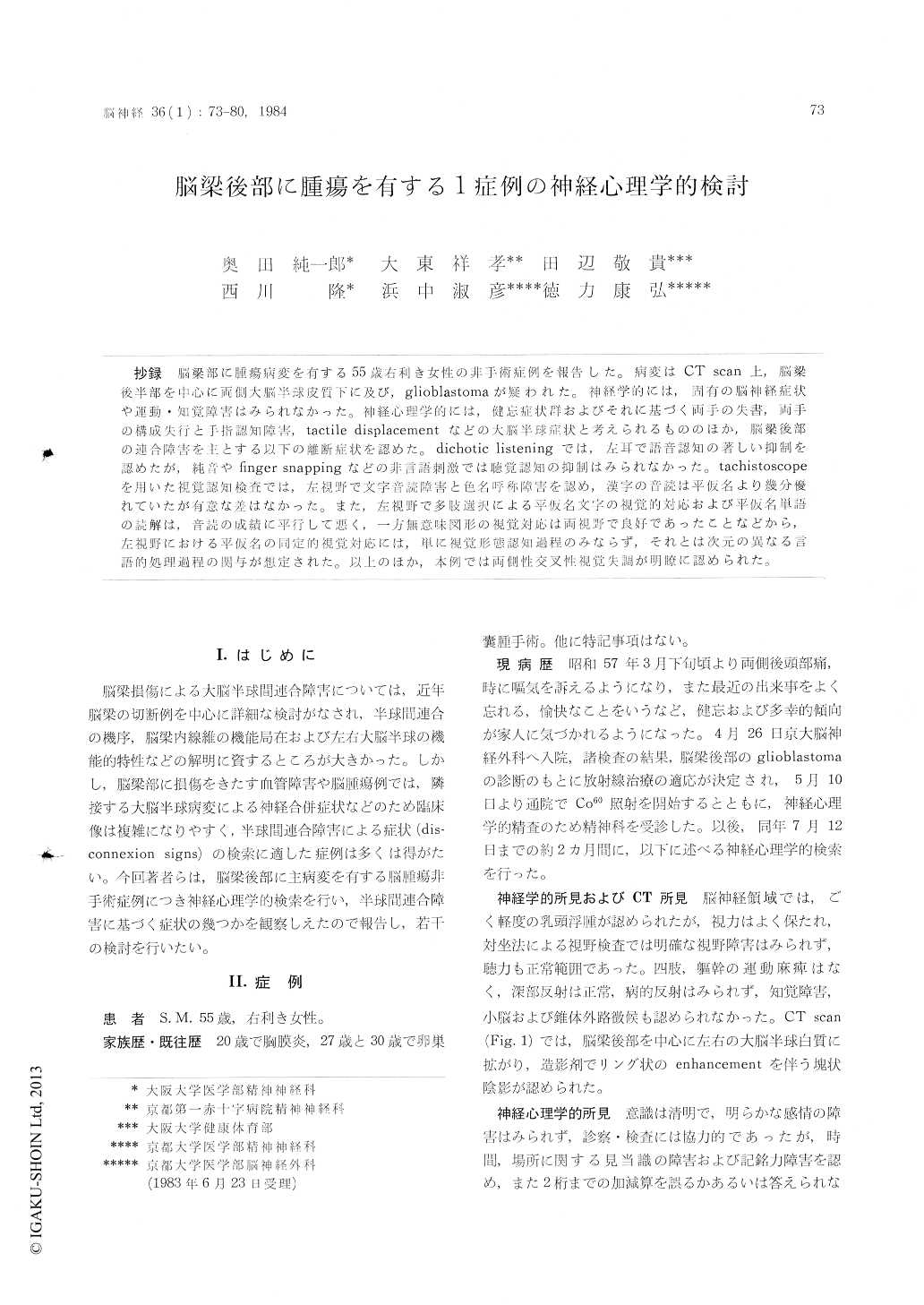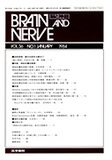Japanese
English
- 有料閲覧
- Abstract 文献概要
- 1ページ目 Look Inside
抄録 脳梁部に腫瘍病変を有する55歳右利き女性の非手術症例を報告した。病変はCT scan上,脳梁後半部を中心に両側大脳半球皮質に及び,glioblastomaが疑われた。神経学的には,固有の脳神経症状や運動・知覚障害はみられなかった。神経心理学的には,健忘症状群およびそれに基づく両手の失書,両手の構成失行と手指認知障害,tactile displacementなどの大脳半球症状と考えられるもののほか,脳梁後部の連合障害を主とする以下の離断症状を認めた。dichotic listeningでは,左耳で語音認知の著しい抑制を認めたが,純音やfinger snappingなどの非言語刺激では聴覚認知の抑制はみられなかった。tachistoscopeを用いた視覚認知検査では,左視野で文字音読障害と色名呼称障害を認め,漢字の音読は平仮名より幾分優れていたが有意な差はなかった。また、左視野で多肢選択による平仮名文字の視覚的対応および平仮名単語の読解は,音読の成績に平行して悪く,一方無意味図形の視覚対応は両視野で良好であったことなどから,左視野における平仮名の同定的視覚対応には,単に視覚形態認知過程のみならず,それとは次元の異なる,言語的処理過程の関与が想定された。以上のほか,本例では両側性交叉性視覚失調が明瞭に認められた。
A case of 55-year-old right handed woman who had a tumor lesion in posterior corpus calloum is studied. The patient was admitted to the hospital with the chief complaint of headache on April 26, 1982. In neurological examination, a slight degree of papilledema was observed at that time, but visual acuity was well preserved and visual fields displayed no remarkable constrictions. She showed no other cranial nerve disturbances or sensorimotor deficits. Computerized tomography of the brain (Fig. 1) revealed a tumor lesion centered in the posterior half of the corpus cal-losum, extending bilaterally into the surrounding white matter. The diagnosis was glioblastoma and radiotherapy was indicated.
She was alert and co-operative to a series of neuropsychological examinations, although she was in amnestic state with disorientation and recent memory loss, but without confabulation. She was not aphasic. Object naming and reading of letters were normal. Ideomotor or ideational apraxia and unilateral spatial neglect were not seen. She was able to draw some pictures by instructions and to copy letters correctly with right and left hand (Fig. 2). She showed amnestic agraphia in Kanji letters (Fig. 3), constructional apraxia (Fig. 4) and slight finger naming deficits, respectively on either hand. Tactile displacement was frequently observed on either side of the body.
In addition to the symptomes described above, which were thought to be due to cerebral hemi-spheric lesions, the following interhemisphericdisconnexion signs were observed. Tactile object naming and tactile reading with the left hand were disturbed to some extent, but equivocally. Bilateral crossed visuomotor ataxia was clearly recognized, which will precisely be reported elsewhere.
Dichotic listening test revealed marked left ear extinction in Japanese single vowels (Table 1). In this occasion, the patient replied that she heard the sound itself in the left ear, but could not iden-tify it. When nonlinguistic sounds, such as pure tone bursts and finger snappings, were dichotically presented, she could hear them in each ear. Thus, it was suggested that posterior callosal lesion would give rise to the left ear cognitive suppres-sion, not in acoustic level but in linguistic level.
Results of tachistoscopic half field presentation test were summarized in Table 2, where oral read-ing or naming. and/or delayed visual matching by multiple choice were tested in each stimulus category. Reading letters and naming colors were disturbed in the left visual field. Performance of reading Kanji in the left visual fields seemed better that of reading Hiragana, but the difference was not statistically significant. In letter-to-letter and word-to-picture matching tasks in Hiragana, the rates of correct responses in the left visual field remained within the chance levels and were signi-ficantly lower than those in the right visual field. In contrast, performance of visual matching in some nonsense shapes (Fig. 5), the size and the level of complexity of which were nearly the same as those of letters, was almost equally fair in two visual fields, and was significantly above the chance level. From these results and other available data in literatures, the authors would propose a hypo-thesis, at present, that, in order to achieve the visual matching task for identifying letters, espe-cially in Hiragana, not only the visual configura-tion cognitive processing, but also linguistic cog-nitive processing which might he on a different plane from the former, would co-operate either simultaneously or successively.

Copyright © 1984, Igaku-Shoin Ltd. All rights reserved.


